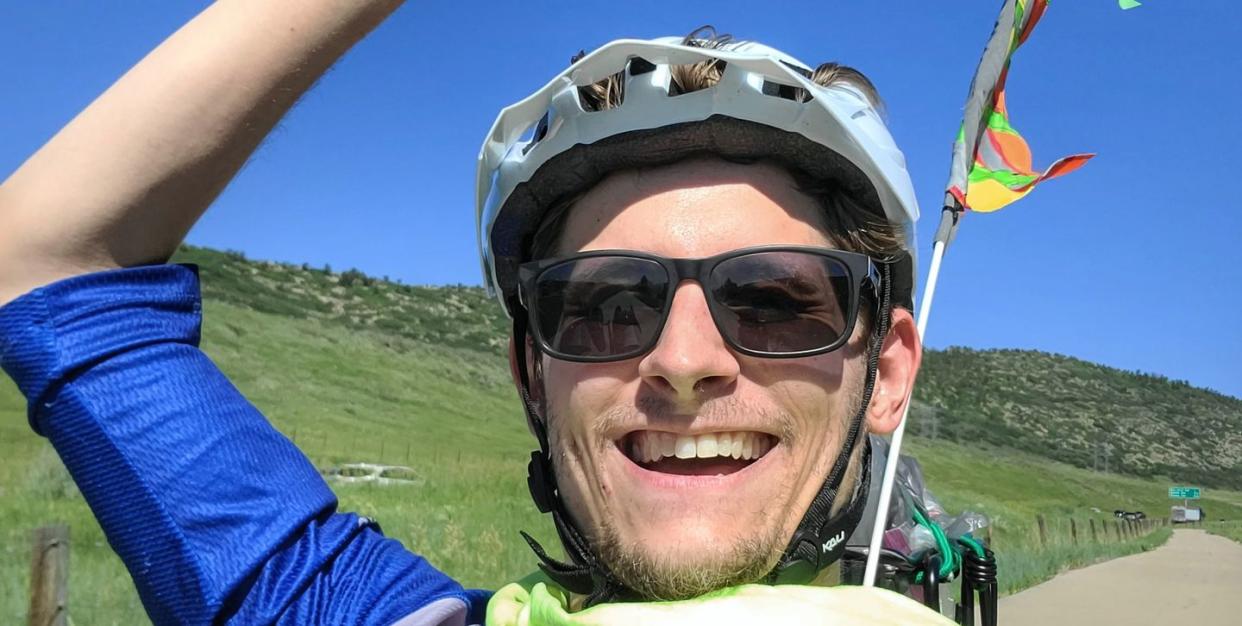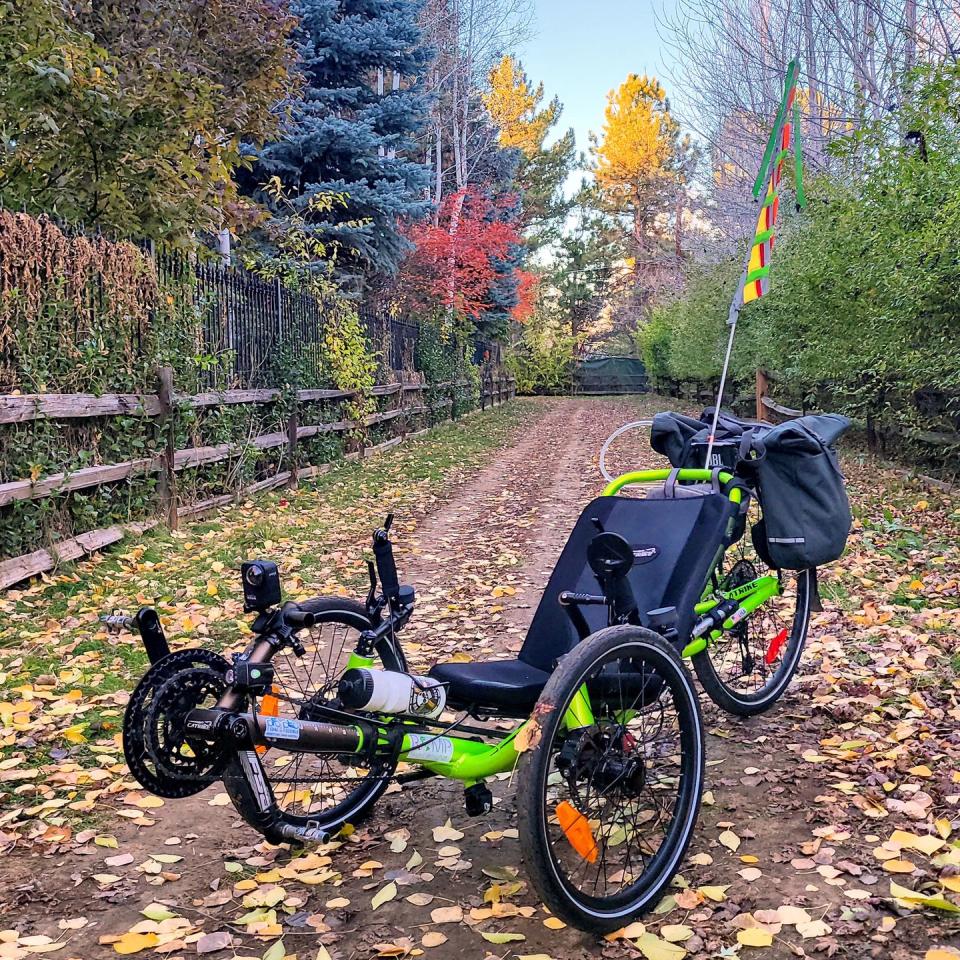After Two Amputations, This Cyclist Started a Club for Athletes Like Him

"Hearst Magazines and Yahoo may earn commission or revenue on some items through these links."
Name: Nicholas Young
Age: 34
Hometown: Denver, Colorado
Occupation: Director of Information Security
Time Cycling: 12 years
Reason for Cycling: I ride for cardiac fitness and rapid city transportation.
I purchased my first commuter bicycle in 2010, shortly after the historic floods ravaged my then-home of Nashville, Tennessee. I had planned a move to Chicago for work and decided while the CTA (public transportation) would mostly satisfy my needs, an alternative mode of transportation would also be helpful.
Even while riding on the relatively unfriendly (at the time) Nashville streets, I discovered an unexpected love for human-powered transport. It seemed that many of my friends lost that magic when they graduated into adulthood and learned to drive. I wanted to keep it alive.
Later that year, after we moved to Chicago, cycling became much more than a hobby. I was impressed that city planners created space for cycling, rather than leaving it as merely an afterthought. During that move, however, a collection of chronic, cardiac-related health conditions began to make an appearance, and before I knew it, I was unexpectedly passing out multiple times per day. My doctors prescribed low-impact, high-cardio activities that were relatively low risk and I decided that meant cycling.
At the start, I was riding to maintain quality of life. I had no goals other than to avoid the dangerously high heart rate and frequent exhaustion that resulted from my genetic health condition. If I look back at the routes I was riding in 2010 through 2012, they were 10- to 20-mile round-trip adventures. But I had started with less than a mile, slowly increasing by roughly 10 percent per week and doing what I was able to handle.
This process of gradually increasing my distance and frequency continued until 2015, when I was using my bike as a principal mode of transportation, largely ignoring public transport, and had become much more acclimated to riding on city streets—or so I thought.
My life changed shortly after that. In late 2015, I was cycling down Montrose Avenue in North Chicago. As I approached the intersection with Ravenswood Avenue, my front wheel entered a deep pothole, which threw me from the bike and onto wet, grimy asphalt. I assumed this was a “normal” crash. After all, I’d bounced off vehicles that entered my lane before. This time, I was wrong about the crash for one reason: my right ankle and foot had become lodged between the crank and frame, and both were swelling so rapidly it was hard to untangle the mess.
This resulted in what doctors would later call injury-inflicted nerve damage, which led to a condition known as complex regional pain syndrome (CRPS) in my right leg. That meant I couldn’t simply “walk off” this injury, and I spent the greater part of the next three years attempting to live with the pain. I moved cross-country from Illinois to Colorado to access medical cannabis, which gave me some relief, but, in the end, I lost cycling and sports of any kind to this injury. Those years were dark.
After attempts to salvage my right ankle failed, I opted to electively amputate my right leg below the knee in October 2018, which opened a new chapter for me. Within a few months, I was riding again. Although my balance wasn’t what it once was (and my cardiac fitness had dwindled to 2010 levels), I was able to compensate by transitioning to a recumbent tricycle, specifically the Catrike Trail. Thanks to a grant from the Limb Preservation Foundation, I received my trike in early 2019, and proceeded to ride about 300 miles across the state of Colorado.
Unfortunately and unknowingly, my increased levels of activity were destroying the joints in my left ankle and foot and exacerbating another condition. So in late 2019, I had to take a break from riding again. This time, I decided to forgo the usual limb salvage process in my left leg, and instead proceed directly to elective amputation. In early 2020, I had my left leg amputated below the knee. By mid-year, I was back on my tricycle.
During the 2021 season, I completed more than 700 miles and was a member of the top fundraising team for Craig Hospital’s Pedal 4 Possible Fundraiser, which benefits adaptive therapeutic recreation. However, this past year has been my most successful yet: I rode more than 1,000 total miles and alongside my team, raised more than $20,000 for programs at Craig.
Becoming a bilateral amputee has changed how I ride from a biomechanics perspective. It has also made me, I hope, kinder to myself. I’m less concerned about the miles, and more focused on the adventure (even though I’m sure I log more distance now than before). I’m also very aware it means I have less muscle to power the same propulsion system that every cyclist uses, but I’m open to the challenge.
This led me to found the Misfits Cycling Club in the summer of 2022. I was looking for friends to join me on long, and otherwise solo, routes. After years of frustration that I couldn’t simply join a club, I decided to create one, along with a friend.
We created and led several rides this past year in the South Denver area. Our members are a diverse set of folks, all with different conditions or disabilities, but all found their home on three wheels. You can follow our adventures (or join an upcoming ride) at misfitscycling.org.
I’m often able to squeeze in about 10 to 15 miles before or after work on most weekdays, increasing to 25 to 35 miles on the weekend. On a good week, I average about 100 miles. Fortunately, Colorado has plenty of sunny days where I can always put in a few extra miles.
To prepare, I follow a pattern similar to other cyclists: Start small and increase my distance by small amounts each ride, as time allows. Before heading out, I first check to ensure I have a couple liters of onboard hydration, at least one tube of Nuun electrolyte booster tablets, and check the tire pressure. I also ensure my prosthetics fit comfortably, put sunblock on exposed skin, and then clip into my Crankbrothers Eggbeater pedals before riding off.
Adaptive riding is, to a point, a team sport whether you recognize it or not. Your teammates might not be other riders, but instead include prosthetics and orthotic providers or rehab therapists. Listen to their contributions, but always remember: You’re the leader. Sometimes that requires decisive calls and reshuffling of your team.
Don’t give up, even if the distances you’re riding are short and seemingly impossible at the start. Attempt to avoid comparing yourself to others, and instead, be happy with setting goals you will personally find worthwhile, then enjoy the ride. Whether you’re fast or slow, it doesn’t matter, as long as the cranks are turning!
If you’re struggling with back pain or another chronic ailment, there is likely a frame style or ergonomic adjustment, which may relieve the pain. I know many riders live in a so-called “cave of pain,” but especially for adaptive riders, listening to your body and following up with your orthopedic and or surgical teams when something doesn’t feel right is a critical element of achieving top performance.
Even when walking was difficult over the last few years, I could still ride. Cycling is, in a word, freedom. It’s the ability to explore while improving physical health.

These three tips have made my cycling journey a success:
1. Ride for yourself
A lot of adaptive riders don’t find a club at the start, and some, like myself, eventually go on to create the club they always wanted. Still, group rides can’t be your only motivation. It’s important to find your internal drive and use it as fuel to get up and do the work.
2. Take it at a comfortable pace
This is true for all cyclists, but especially so for adaptive riders. Your journey won’t look the same as anyone else’s. My journey has been punctuated by the need to design new prosthetics for recumbent cycling, not to mention all of the medically-imposed breaks. Whether you’re returning to cycling after a long break or attempting to use it as rehab, be prepared for it to take a few years for you to find your rhythm. Speed and endurance will come in due time.
3. Set different weekly goals
Not only does this help prevent your daily exercise from becoming drudgery, it works different aspects of your fitness. I tend to do short rides throughout the week, focused on consistent speed and how I carry my weight on the frame around corners. The weekend is for more endurance-focused challenges, where I worry less about speed and instead focus on achieving a specific distance goal, within an achievable but flexible time window. While this isn’t trainer-approved, it has worked for me so far.
Nicholas’s Must-Have Gear
→ REI Beyonder Panniers: This bag has been with me throughout the entire 2022 season, and shows no sign of wear.
→ Crankbrothers Eggbeater: These weird-shaped pedals are my dream as an adaptive rider, for many of the same reasons cross-country folks like them: multiple clip-in points and superior mud shedding make clipping in with my prosthetics a breeze by comparison to other systems.
→ Topeak Mini Morph Pump: It’s a tiny wonder, but packs the ability to inflate even large tires without wearing out your arms. This little pump has saved me many times on the trail. You’ll need a Schrader adapter to make this truly universal, but those are easy enough to find.
→ Nuun Electrolyte Tablets: These allow me to carry more water and less liquid when I go out, with the knowledge that I can always improve the effectiveness of my water if needed. Plus, there’s less sugar than a bottle of your normal sports thirst-quencher.
We want to hear how cycling changed you! Send your story and submit your photos to us via this web form. We’ll pick one each week to highlight on the site.
You Might Also Like

